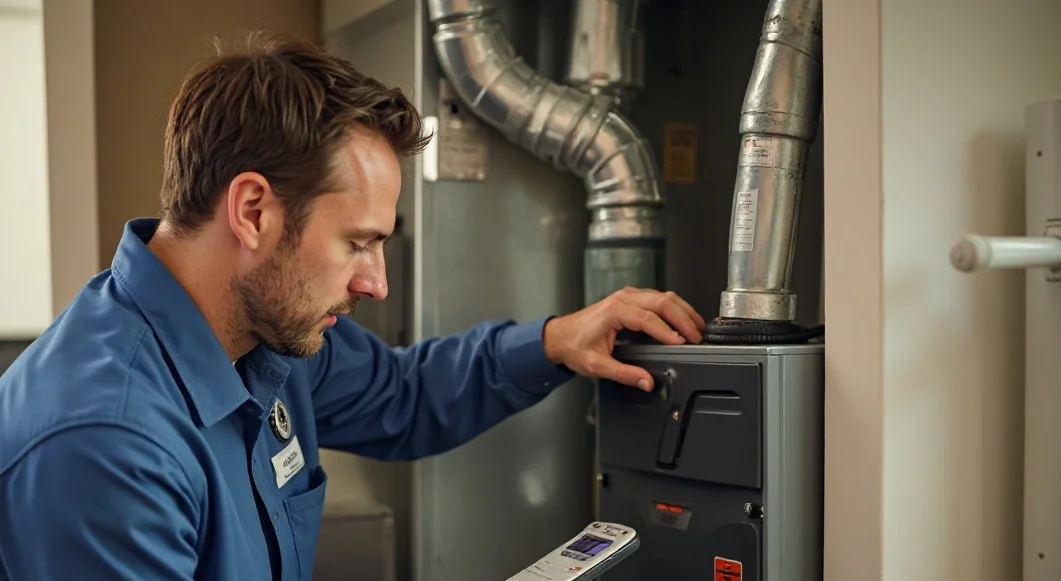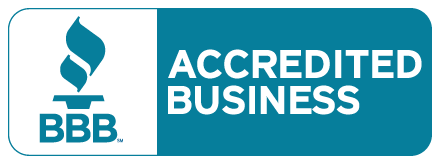For your furnace safety checklist, check its power, fuel lines, filters, venting, wiring, and safety components before winter starts. These checks prevent breakdowns, improve efficiency, and reduce safety risks.
Living in Middlefield means dealing with long, cold winters, and your furnace needs to be ready before the first freeze hits. If it’s been sitting idle since last spring, now is the time to make sure everything is working properly.
In this guide, you’ll learn what to check, clean, or test to make sure your furnace is safe to operate. We suggest homeowners follow these furnace safety tips every fall to reduce the risk of no-heat emergencies, carbon monoxide leaks, and costly mid-season breakdowns.
If you’d rather have a professional handle it, call Direct Home Services at (860) 339-6001 to schedule a furnace tune-up before the cold sets in. We’re located at 478 Main St, Middlefield, CT 06455.

1. Power & Fuel Supply Checks
Check the furnace’s power switch, fuel lines, and shutoff valves before the heating season to protect your home from leaks, electric hazards, and unexpected breakdowns.
Switch off the power to the furnace at the nearby wall switch or circuit breaker before beginning inspection. Next, locate the emergency shutoff valve for your gas or oil supply. Turn it fully off, then back on, to confirm it moves freely and isn’t stuck.
Follow the gas or oil line and look for rust, cracks, or worn fittings. If you smell gas (sulfur or rotten egg odor), leave the house immediately and call a licensed HVAC technician. For oil systems, check that the tank is at least half full and that the fuel line isn’t damp or corroded.
If you have an electric furnace, open your breaker panel and confirm the circuit is clearly labeled and hasn’t tripped. Look for any signs of overheating, like black marks or melted insulation.
2. Air Filter Inspection
Replace or clean your furnace air filter every 1–3 months to prevent airflow problems, overheating, and poor indoor air quality.
With the furnace turned off, open the filter compartment, usually located between the return duct and the furnace cabinet. Slide the filter out and hold it up to a bright light. It needs replacement if you can’t see through it or if you see heavy dirt and debris.
Make sure to use the size printed on the frame to buy a matching filter. Most Middlefield homes use 1-inch filters, but high-efficiency systems may require thicker ones.
Replace the filter by sliding the new filter in with the arrows pointing toward the furnace. Close the compartment and restore power.
Pro Tip: Check the filter every 30 days from October through March, and keep a few spares on hand so you’re not caught without one when it’s cold.
3. Thermostat & Control Settings
Test your thermostat and control settings before the heating season begins to confirm the furnace responds correctly and maintains safe, consistent temperatures.
Start by switching your thermostat to “heat” mode. Raise the temperature setting at least 5°F above the current room temperature and listen for the furnace to turn on. If nothing happens, check that the thermostat has working batteries (if applicable), the display is lit, and the furnace power switch is on.
Make sure the fan setting is on “auto” so it only runs during heating cycles. This helps prevent the blower from running constantly and pulling in cold air when the system isn’t heating.
If you use a programmable or smart thermostat, review the weekly schedule to ensure it reflects your current needs, especially from October through April in Middlefield, CT.
You can set the furnace to lower temperatures during the night or when you are away, but avoid letting the house drop below 60°F to prevent frozen pipes.
4. Venting & Exhaust System
Inspect the furnace exhaust pipe and venting system for blockages, corrosion, and loose fittings to prevent carbon monoxide buildup and ensure safe operation.
Go outside and locate the furnace exhaust vent. This is usually a metal flue or PVC pipe. Make sure the exhaust vent is clear of leaves, snow, nests, or animal debris. Clear at least a 12-inch radius around the vent.
Back inside, follow the vent pipe from the furnace to the wall or chimney. Look for rust streaks, gaps, sagging pipes, or signs of condensation. Metal flue pipes should be tightly secured with screws at each joint and show no evidence of flue gas leaks (white powdery residue or dark soot at seams).
5. Electrical Connections & Wiring
Inspect your furnace’s wiring, breaker, and connections for signs of wear, heat damage, or loose terminals to reduce the risk of electrical failure or fire.
Turn off the power at the furnace switch or circuit breaker before opening any panels. Carefully remove the heater’s front access panel and examine all visible wires. Look for frayed insulation, discoloration, scorch marks, or melted connectors.
Gently tug on terminal connections to check for looseness, especially around the blower motor and control board. Loose connections can cause arcing, which may damage components or start a fire. If you see wire nuts or electrical tape, verify they’re secure and not brittle or cracked.
Go to your home’s electrical panel and confirm the furnace breaker hasn’t tripped. In Middlefield homes, furnace circuits are typically 15 or 20 amps. If it trips repeatedly, contact a licensed electrician or HVAC technician.
Pro Tip: Take a photo of the internal wiring layout before closing the panel. If a wire ever comes loose or a part needs replacing, you’ll have a reference for safe reconnection.
6. Flame Sensor & Burner Operation
Check the flame sensor and burner for dirt, corrosion, or abnormal flame color to ensure the furnace runs reliably and prevents system lockouts during cold spells.
With the thermostat calling for heat, watch through the burner observation window for a steady blue flame. A different color, especially a flickering yellow or orange flame, signals dirty burners, poor combustion, or a ventilation problem.
If the furnace turns on but shuts down within seconds, the flame sensor may be dirty. Turn off the power and remove the sensor (usually held by one screw near the burner assembly). Clean it gently with fine steel wool or a dollar bill. Never use sandpaper or chemicals and reinstall securely.
Also check the ignitor and burners for dust, rust flakes, or soot. If burners are noisy or the flame lifts off the burner, shut down the system and schedule a professional inspection.
7. Carbon Monoxide & Smoke Detectors
Test all carbon monoxide and smoke detectors monthly, replace their batteries yearly, and confirm proper placement to protect your household from invisible furnace-related hazards.
Carbon monoxide (CO) is colorless and odorless. A malfunctioning furnace can release it without warning. Install a CO detector on each level of your home, especially near bedrooms and the furnace room.
Press the test button on each CO and smoke detector. The alarm should sound clearly. If not, replace the batteries and test again. Replace the unit if it fails again, as most detectors have a lifespan of 7–10 years.
8. Blower & Motor Function
Inspect the blower and motor for dust buildup, odd noises, or delayed startup to prevent performance issues and overheating.
With the power turned off, remove the blower access panel, which is usually located below the burner compartment. Use a flashlight to inspect the blower wheel for dust, pet hair, or debris.
Gently spin the wheel by hand. It should turn smoothly without grinding or wobbling. If the motor has oil ports (most newer models do not), apply a few drops of non-detergent oil. Check wiring to the motor for any signs of heat damage or loose terminals.
Restore power and raise the temperature to start a heating cycle. Listen for unusual sounds such as rattling, squealing, or buzzing. This could mean loose mounting bolts, worn bearings, or an unbalanced fan.
9. Safety Labels & Access Panel Seals
Check that all safety labels are intact and access panel seals are tight to prevent exposure to hot components, moving parts, or combustion gases during furnace operation.
Before turning the heating system on for the season, inspect every panel, including the burner. Make sure all safety labels, such as warnings about high voltage, hot surfaces, and moving parts, are readable and securely attached.
Next, verify that access panels are seated properly and latch or screw in firmly. On most units, the blower door has a built-in safety switch that disables the furnace if the panel is removed. If this switch is bypassed or damaged, it poses a serious safety risk.
10. Schedule Professional Furnace Maintenance
Book a licensed HVAC inspection every fall to catch early issues, improve safety, and keep your furnace reliable during Middlefield’s long winter season.
Even with regular homeowner checks, a qualified technician should inspect your heating system annually. They’ll follow a detailed furnace inspection checklist that includes:
- Testing the heat exchanger for cracks or corrosion that could leak carbon monoxide
- Measuring gas pressure and burner performance to confirm safe combustion
- Checking the ignitor and flame sensor for wear or carbon buildup
- Inspecting and cleaning the blower assembly to ensure proper airflow
- Lubricating moving parts (if applicable) to reduce friction and wear
- Inspecting the flue and venting system for blockages, leaks, or backdraft risks
- Verifying electrical connections and tightening terminals to prevent arcing
- Checking safety switches and limit controls to confirm proper shutoff function
- Testing the thermostat for accurate temperature control and response
- Running a full system startup and shutdown cycle to observe any irregularities
We suggest Middlefield, Connecticut, homeowners book a furnace inspection and maintenance between late September and early November.
Call an HVAC Technician Before Cold Weather Hits
Get ahead of winter by checking your furnace’s power, fuel lines, filters, wiring, and safety components now. These quick inspections help prevent heating system emergencies and costly breakdowns in Middlefield’s freezing months.
While this checklist covers what you can safely do yourself, calling a Middlefield HVAC technician can run advanced diagnostics and fix issues before they cause a system failure.
Call Direct Home Services at (860) 339-6001 to book furnace maintenance and repair service.
FAQs
How often should I have my gas furnace inspected by an HVAC technician?
Gas furnaces should be inspected by an HVAC technician once a year, ideally before the heating season.
What are the signs of a cracked heat exchanger in a furnace?
Look for soot buildup, a yellow burner flame, or strange smells. A cracked heat exchanger may also cause the furnace to shut off frequently or trigger a carbon monoxide detector.
Can blocked air ducts cause a furnace to overheat or shut down?
A blocked air duct can reduce airflow, which can cause the furnace to overheat or shut off. This puts strain on the system and may damage internal components.
When should I schedule furnace repairs instead of trying to fix it myself?
If your furnace won’t start, makes unusual noises, or keeps shutting off, schedule professional repairs. Attempting DIY fixes on gas or electrical components can be unsafe and lead to bigger problems.


